Ever go about your day doing the same things you’ve done a thousand times before and then WHAM! something unexpected happens? That’s what happened to me recently when I was shooting some 44 Magnum handloads. Having just gotten my S&W 329 PD setup for summer carry, I thought I would test some ammo with it. What happened surprised me!
Pressure Signs: Proceed Carefully
When I opened the cylinder on my S&W 329 PD, I saw a problem immediately. What looked like charred edges around the primer of one of the cases, and the rest of the cases had flattened primers. WHOA! I thought- I need to figure out what’s happening here!
So I grabbed my 4″ Stainless 629 and shot some of the same ammo. SAME RESULT. And the same result with my 6″ 629. This was definitely an ammo problem! I’ve shot this load in these guns for years and have never had an issue until now. And it was clear that this was something to take seriously.
The Load
The load in question is the following:
- Starline previously fired 44 magnum case
- Hornady 240 grain XTP bullet
- 24.0 grains Hodgdon H-110 (max load)
- Winchester Large Pistol Primer (for standard or magnum loads)
Use load data at your own risk. Ultimate Reloader is not responsible for errors in load data on this website. Always cross-reference load data with manufacturer’s published data.
Investigation
Powder Charge
The first thing I took a look at was the charge weight. I broke down a few cartridges using my Frankford Arsenal Impact Bullet Puller so that I could weigh the charges. It turns out, the charges were at or below the 24.0 grain load.
Correct Powder
I did wonder if I used the wrong powder, or if the powder had been contaminated. So I compared the appearance of the powder from a broken down cartridge to some H-110 from a sealed container- they appear to be the same albeit with a VERY slightly different color. I suspect the color difference could be due to lot-to-lot variances. The consistency of this flattened ball powder looks the same.
Here’s a closeup showing the powders side by side: (click/tap to enlarge: H-110 on left, mystery powder on right)
Correct Primer
The second thing I did was to use a decapping die to knock a primer out of one of the cases from the broken down cartridges. I carefully compared the primer to the correct one (from my primer storage area) and found the color coding to be identical, and the outward appearance as well. Yes, this was a standard Winchester Large Pistol primer as it was supposed to be…
Correct Velocity
I shot some of this ammunition over a chronograph, and got velocities within the range I expected… And I also got some BIG FLAME BALLS! Gotta love that.
The Hornady load manual indicated just over 1300 FPS for this load, and I measured average velocity at 1287.6 FPS. So velocity isn’t out of spec.
Other Things I’m Going To Look At
I haven’t solved this mystery yet, but I’m going to keep working at it:
- Check primer pocket diameter on burned-out cases- perhaps the brass is worn out and primers aren’t held securely.
- Replicate the exact load, test in my three 44 magnum revolvers.
- [I’m open to suggestions! Please leave a comment]
I’m hoping that I can figure out what was going on here- both to satisfy my curiosity, and to avoid these kinds of issues in the future. If I do figure this out, I’ll certainly keep you all updated.
Don’t miss out on Ultimate Reloader updates, make sure you’re subscribed!
Thanks,
Gavin

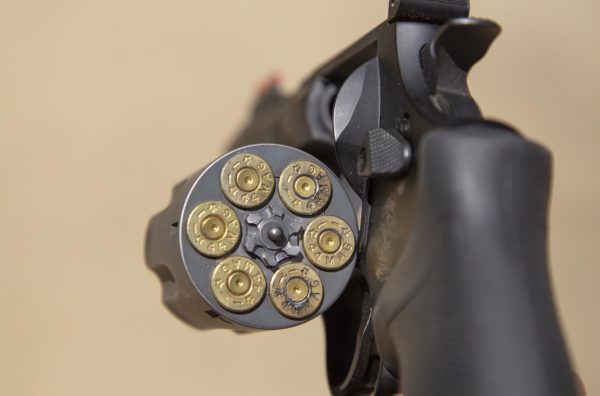
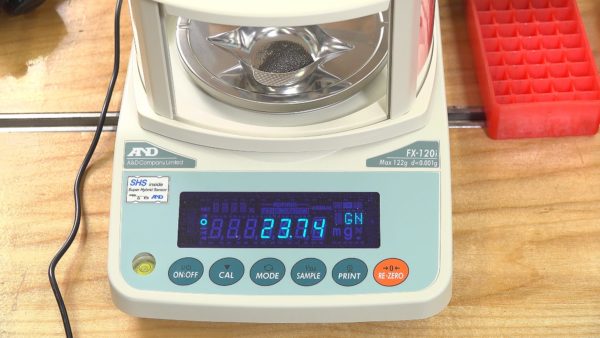
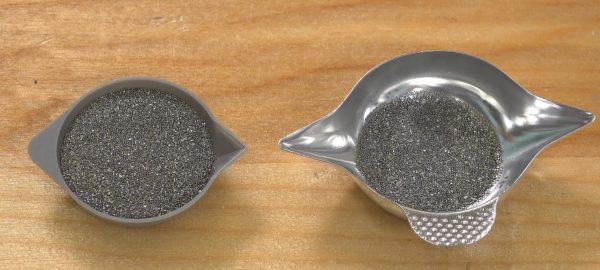
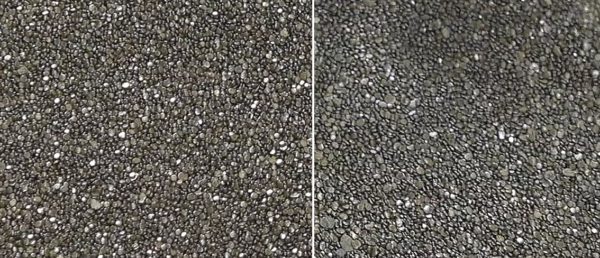
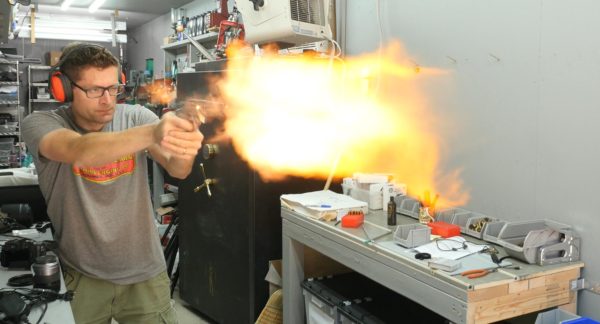

















































































One thing I didnt hear you mention was how heavy of a roll crimp was used. Also excessive pressure can be caused by brass being to long. The way the cases looked in the cylinder seems to indicate that the problem might be in only one or two chambers. If you shoot cast lead bullets out of the revolver check to see if the the cylinder and forcing cone have any lead deposits. Other than that my first guess would be loose primer pockets. I hope you find the cause, I’d like to know myselfe. Best of Luck, Keith
Hey, Gavin love your videos. I have the noticed the same problem with my S&W 686+ with black star burst around the primmers and flatten jagged edges with only Winchester brass. I just thought the brass primmer pockets were worn. Tossed the brass but I noticed that the firing pin bushing was all eaten and pitted from the hot gas leak from the primmer. Sent gun to S&W for repair. Hope this helps have a great day! Lee
There are lot to lot variations on powder and primer, I’ve seen as much as 10%, but that was many years ago, today things seem a bit more consistent, but still a possibility. With your 24g load, being max book load, get a slightly more energetic lot of powder/primer combination and that might be enough to get you to over acceptable pressure.
Check the bore of the revolver for excess jacket fouling? Unlikely as it happened across 2 different firearms.
Has the level of crimp changed possibly? That initial pressure rise on an over crimped projectile could get you an momentarily high pressure spike.
Also check the flash hole diameter, functionally the primer/flash hole is a kind of hydraulic piston setup, so a oversize flash hole could allow more pressure to act on the primer, giving the over pressure signs.
I had a similar flattening of primers recently. I was about to begin loading for my lever action so concerned.. I looked at a couple loads and noticed high primers, not very much but above flush of base.. I went thru and used my hand held primer pocket tool in my cordless drill and primers are all now below flush.. even with plat points I want recessed primers.. I think this could lead to flattened primers.. just my 2 cents
Just out of curiosity, how old are your Winchester primers? If it’s not too late, closely examine the primers rounded “shoulder” in the scorched area for a pinhole(s). Winchester had a run of primers a few years ago that were either soft or thin in that area. I experienced that with those damn primers a few years back, to include “flame-cutting” of the recoil shield of my beloved 29-2. I’ve still got about 9,900 of them left.
Why not load some ammo with the same components only different by using the powder from the new just unsealed package? This can figure out the old powder as the source of the problem.
My first thought was that the crimp might be too tight inline with what JD posted. It has happened to me with .44 mag but it was my fault for not keeping the cases trimmed enough.
Hey Gavin. What about the brass? Could the primer pocket have been slightly oversized on a few cases (the ones you had the over pressure signs on) allowing the gases to escape thus leaving and giving you the blackened powder marks at the primers as seen?
Ask me, I don’t know. Just throwing it out there for you to check.
Hi Gavin, I have found that powders such as W296 and H110 are very temperature sensitive, ie pressure increases with temperature increase. Given that it is a max load, if it was quite hot when you were test firing, reduce temperature of ammo in a coolbox (not too cold) and try again.
Barry
Yes you should be concerned. Multiple over pressure signs each one significant in its self. I don’t know how temperature sensitive H110 is, but I’ve always heard this a powder that’s quick to SPIKE.
In this day and age of optimum manufacturing consistency, the advice to rework a load with every new lot just might be prudent.
One last thought, 10% still leaves room to reduce your powder charge and I’ll bet there’s no reduction in the fun factor. Your revolver might like you better too?
had the same issue after a change to federal primers. 250 gr cast bullet, 21 gr 2400 powder. a switch to any other primer solved the issue. Hope that is helpful.
I have read something about “bullet weld” on centerfire rifle cartridges. Haven’t heard anything about it on handgun cartridges but could this be another possibility?
Had something very similar to this with my 338-06 and H380 powder, new winchester brass and primers. Turns out it’s a known winchester primer problem. I switched to CCU primers and all gasses went out the proper end of the firearm.
Did the “over pressure” cases extract harder?
You could set up 2 loads
A. 6 rounds with same primers and plastic practice bullets.
B. 6 rounds with different primers and plastic practice bullets.
Cut 12 wooden blocks 2×2 that will slide into a piece of pvc pipe. Adjust wt. by sanding (use that niceFX120i)
Set up and shoot 12 shots alternating shots from A and B.
Load block into pipe(aimed in a safe direction obviously) push it same distance into pipe for each shot with end of barrel.
Shoot and carefully measure distance block has moved. You may have to tinker with block wt. till you get measurable results.
If there is much difference in the primers it will show up in the distance the blocks move.
Did you load any rounds with different primers and same powder and charge?
Different lot powder and suspect primers?
Have you used any of the suspect primers in any other caliber loads with same powder?
Have you miked the bullets? Over the years I have had two incidents (one with cast and the other with jacketed bullets – both were sold as .429) where the bullets were oversized. Both bullets showed signs of overpressure. I resized the cast bullets and that not only fixed the over pressure signs but also improved accuracy. I contacted the manufacturer of the jacketed bullets who requested I send them back. They sent replacement bullets and when I miked the replacement bullets they were correctly sized. Now when open a new box of bullets I spot check a few of the bullets to confirm correct bullet size.
Gavin,
I had this same issue with my S&W model 57 41mag using Winchester LP primers and Remington brass. I did the same thing, pulled several apart and checked charge weights. All within a 1/10th of grain from my 17.0g of 2400 which is well below max book load. I found blog posts about Winchester primers being the cause. I don’t record production lot #s on my loads, but I wished I did in this case because the manufacture would know if they had a bad lot and replace them. I switched to CCI.
I remember reading a while back that Hornady XTP bullets have a longer bearing surface than a non-XTP bullet of the same weight. This would raise pressure because of the longer bearing surface.
I run 23.5 grains of H110 with a 240 grain jhp non XTP bullet with zero trouble and have for years. A half grain less powder won’t amount to a loss of velocity that is noticeable.
Running max load puts you subject to overpressure from tight barrels, bullets seated too deep and pressure increase from heat and sunlight.
I would personally look at the primers and see if the problem recurs with other primers. As others have noted, there was recently a run of Winchester pistol primers with thin primer cup material that was a bit thin, that was prone to this.
If your powder charges are the correct weight and the velocities are within spec, your pressures are surely within spec also.
Maybe load up another batch with, say, maybe, CCI Large Pistol Magnum primers, and see if this happens again.
Some here have suggested significantly reducing the powder charge, but H110/W296 is one of those powders that has significant problems with consistent ignition with reduced powder charges, especially in cooler weather, or with a lot of primers that had a bit less “umph.” Winchester and Hodgdon load manuals until pretty recently said, for all their H110/W296 loads, “use EXACTLY AS PRINTED, do NOT reduce!”
There are powders suitable for high end .44 Mag loads that tolerate reduced charges. Alliant 2400 and Accurate Arms #9 are perfectly fine with reduced charges and 2400 doesn’t even need magnum primers. Not knocking H110 or W296 here, by the way–it’s just that it was formulated a specific way for a specific purpose (.30 Carbine military ammo) and it’s made to be used in a specific manner under certain specific circumstances.
Speaking of loads for bear country, I’d have been thinking in terms of full-on Keith loads–250gr SWC of hard lead alloy over 22.0gr 2400. Not sure how well an alloy framed revolver would stand up to those, though–they are the real deal, 1400+ f.p.s. from 6″ revolvers and have been known to damage forcing cones with heavy use. I don’t know that that’s necessary, but it depends on what you want to do. People have been shooting whitetail deer with warm .44 Special loads with 250gr lead SWC over 7.5gr Unique for a hundred years now and it’ll go through both shoulders of a 200 pound whitetail and smash all the bones along the way. How much more juice do you need to reach a bear’s heart? How thick are they? Of course, if you’re in the Kenai, the answer may still be “bigger than you thought.” Another Elmer Keith recipe is the 250gr SWC in .44 Magnum brass, over 10.0gr Unique, for 1050-1100 from most 4″ to 6″ revolvers, and that one runs at lower pressures and is a bit more comfortable to shoot–and it’s hard to think of an animal in North America it won’t suffice for, with good placement. I bet it’ll penetrate deeper than those hollowpoints, too–not knocking Hornady hollowpoints either, but different tools have different purposes, right?
When I loaded H110, I always switched to CCI Magnum primers. I load the WLP primers for Unique and other powders, but with H110 and 296, I switched. I know I’m coming along late to the party, but that might be a consideration.
Hi,
A little late.
Did you solve issue…
As other people have stated about certain lot’s of bad Win primers.
Contact Winchester with the lot #’s.
Did you ever de-cap & examine the spent primers??
Is the primer/pocket leaking, or is it a pin hole??
The cylinder picture, look’s like 3 maybe 4 primers.
Haven’t checked all you’re video’s.
Maybe you can do one on Primer pocket tools (gauge’s etc).